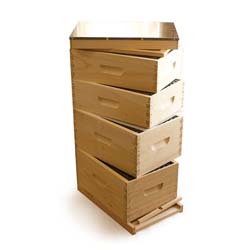There are many options for Varroa mite management, all each focused on combatting this destructive pest. The best way to reduce the threat of Varroa is to implement multiple, complementary practices to better strengthen your hives. Using preventative, mechanical, and chemical methods to control Varroa mites will help with long-term pest prevention.
Prevention
One way to limit Varroa exposure is by ensuring your colonies are strong and have all the resources they need to defend themselves. Good nutrition (honey and pollen stores) can help your bees stay healthy and strong, allowing them to properly defend themselves against potential Varroa infestations. Nutritionally stressed bees are the most susceptible to Varroa and are more likely to perish during the winter.
Prevention is key with pest management. Ways to help prevent varroa mites from spreading through your apiary include:
- Preventing drift, such as the use of different colored boxes, keeping hives at least three to six feet apart, staggering hive placement, place landmarks/visual cues around hives, robbing screens.
- Using mite-resistant bees. Russian bees and varroa sensitive honeybees display more grooming behavior, making them more resilient to Varroa mite infestations.
- A break in the brood. Breaking a brood cycle, by excluding the queen for a few weeks, allowing all brood to fully develop before putting her back in. Keep in mind that the presence of juicy, nutritional larvae – conveniently protected within capped cells – is the perfect environment for Varroa to reproduce.
Mechanical
The next step, after preventative measures, is mechanical in nature. Such methods work when you have Varroa mites in your hives and want to avoid the use of chemical methods to kill them.
- Drone brood removal to lure and remove varroa mites. Drone brood is more attractive to varroa mites (longer periods in the capped cell means more reproductive cycles for the varroa mite). Using special drone frames to act as a lure and then intentionally destroying the frame of brood is a common tool for mite management.
- Implementation of a screened bottom board. This allows loose mites to fall through to the bottom of the hive, becoming stuck beneath the screen bottom. A screened bottom board can be helpful in assessing the extent of the infestation.
- Brood comb modification and rotation.
- Sprinkling powdered sugar on your bees. Powdered sugar helps remove mites by stimulating grooming behavior.
Chemical
Chemical removal methods are often very effective, especially when working in tandem with mechanical methods. There are a variety of proactive treatments. If treating, be sure to read the label carefully and to follow the directions. The first and most important thing is to check your hives regularly for mites and to treat them when you deem necessary. Some treatments include:
Combining different treatment methods from prevention, mechanical removal, and chemical removal can give your bees their best defense against varroa mites.
